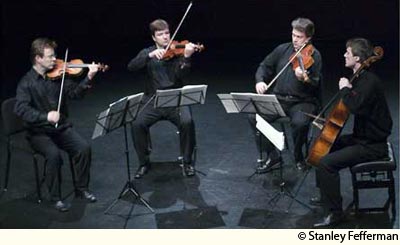| Lutoslawski’s Quartet (1964) speaks volumes: cubes, spheres, vast rhomboid rooms, spiraling helical towers. Listening to this composition reveal itself through the instruments of the Vogler String Quartet is like having the parietal lobe of the brain probed: visual spaces appear — spaces where Calder mobiles dangle, de Chirico rooms meander towards infinity, Braque monoliths populate Easter Island.
The piece is opened by the first violin that utters solo squeaks not unlike amplified bat radar gone random, a tiny rusted hinge speaking to the breeze. The cello lows like an ox in pain, the ensemble flutters, flits in muted pizzicato, explodes like a hive of angry bees, undulating in a texture so dense not a breath is possible.
|
| One feels awakened and in awe of this music, so unsettling in its rawness, so sad in its humanity, offering a kind of consolation through the mastery one feels issuing directly from the mind of the composer.
One listened to Schubert’s last string quartet that followed intermission with ears shaped by the Lutoslawski. Vogler’s phrasing of Schubert’s bold variations produced broadly sculptured passages, voluminous spaces. The plaintive theme of the opening allegro, though sad, contains a masculine strength and determination that steers the mood away from melancholy. The movement’s minor/major changes work out towards a resolution that mingles sadness with gaiety, as in these lines from Yeats’ “Lapis Lazuli”:
On all the tragic scene they stare.
One asks for mournful melodies;
Accomplished fingers begin to play.
Their eyes mid many wrinkles, their eyes,
Their ancient, glittering eyes, are gay.
The exquisite ‘niggunlike’ melody that opens the slow movement, and the lighthearted children’s skipping game theme of the scherzo, are like masses of light colours outlined in strong, dark strokes by the cello. The final allegro, which recalls some of the ambiguous major/minor exchanges of the first movement, but with a heightened sense of drama, resolves in a dance rhythm that recalls the courtly world of Mozart.
This brings us back to our evening’s beginning and Haydn’s E-flat Major Quartet, Op. 64.No.6 (1790). Haydn’s work of this period, when he had returned from England as an international ‘star’ possesses, in Gerber’s words, “the great art of appearing familiar in his themes.” Serious emotion is laced with little laughing runs that reflect in the smiling eyes of the players. This neatly ordered structure gets its own joke.
Steve Kitt of Toronto spoke to us about the concert:
"It was excellent Haydn. The Vogler is a smooth, well-oiled machine. But I have to say, I liked the Lutoslawski better. I’m glad Music Toronto presents music of this type. It was enjoyable and so full of emotion you could hear a pin drop. It was so fluid, and encompassed almost all possible sounds and feelings. The long pizzicato passage was amazing. I thought it was one of the better contemporary works that I’ve heard recently, to the extent that I would like to buy the CD. Yes, I enjoyed it."
|


